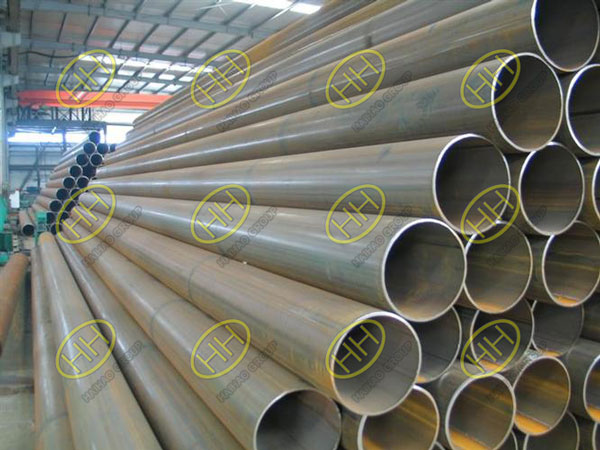In the world of welded steel pipes, two commonly referenced types are ERW (Electric Resistance Welded) and EFW (Electric Fusion Welded) pipes. Although they may look similar at first glance, these pipes differ significantly in terms of manufacturing process, material grade compatibility, applications, and cost.
This article aims to provide a clear and technical comparison of ERW vs EFW steel pipes, helping engineers, project managers, and procurement professionals make informed decisions based on their specific application needs.

The ERW steel pipes produced by Haihao Group’s factory are of high quality
What Is ERW Steel Pipe?
ERW (Electric Resistance Welded) pipe is manufactured by cold-forming a steel coil into a cylindrical shape. The longitudinal seam is welded using high-frequency electrical current, applied through contact or induction, which heats the edges of the strip until they fuse together under pressure. No filler metal is used.
Key Features of ERW Steel Pipe:
- Weld seam is created by resistance heating, not an arc.
- Suitable for carbon steel and low-alloy grades.
- Pipe sizes typically range up to 24 inches (NPS).
- Used mainly for low to medium pressure applications.
Applications:
- Oil and gas transmission lines
- Water and sewage piping
- Structural tubes and scaffolding
- Automotive and mechanical tubing

EFW Steel Pipes Produced By Haihao Group
What Is EFW Steel Pipe?
EFW (Electric Fusion Welded) pipe is typically made from plate or coil by arc welding (electric fusion). It involves creating a weld using an electric arc, with or without filler metal, often in austenitic stainless steel and alloy steel pipes. EFW welding can be applied to both longitudinal and spiral seam pipes.
Key Features of EFW Steel Pipe:
- Weld created by electric arc fusion, often with filler metal.
- Used for high-alloy materials, such as stainless steel and duplex.
- Ideal for large-diameter, high-pressure, or corrosive applications.
- Often subjected to radiographic or ultrasonic inspection.
Applications:
- Chemical and petrochemical industries
- Power plants and heat exchangers
- Desalination systems
- High-purity process lines
ERW Steel Pipe vs EFW Steel Pipe: Technical Comparison
| Aspect | ERW Steel Pipe | EFW Steel Pipe |
| Full Name | Electric Resistance Welded | Electric Fusion Welded |
| Welding Process | Resistance heating, no arc or filler | Arc welding, often with filler metal |
| Material Types | Carbon steel, low alloy | Stainless steel, duplex, alloy steels |
| Weld Inspection | Limited (optional hydro/eddy test) | Often 100% radiographic or ultrasonic |
| Pipe Diameter Range | Up to 24″ NPS | 16″ NPS and above (often large diameters) |
| Common Standards | ASTM A53, A252, API 5L | ASTM A358, A312, A671, A672 |
| Corrosion Resistance | Low to moderate (coating required) | High (inherent to stainless/alloy grades) |
| Cost | More economical | Higher due to material and process |
| Typical Applications | Water, gas, structural | Chemical, oil & gas, high-temperature |
When to Choose ERW Steel pipe or EFW Steel Pipe?
| If You Need… | Choose |
| A cost-effective pipe for water or gas transport | ERW Steel Pipe |
| Corrosion-resistant pipe for chemical processing | EFW Steel Pipe |
| Pipe for high-temperature or pressure applications | EFW Steel Pipe |
| General construction or scaffolding support | ERW Steel Pipe |
| Stainless steel piping with verified weld integrity | EFW Steel Pipe (Class 1, 3) |
Real-World Example from Haihao Group
At Haihao Group, we supply both ERW and EFW steel pipes tailored to client specifications across industries. For example:
For a domestic project, we delivered ASTM A358 Class 3 EFW stainless steel pipes for a chemical plant, ensuring 100% RT and solution annealing.
For an oil pipeline project in Saudi Arabia, we provided API 5L Grade B ERW pipes with hydrostatic test and black painting for corrosion protection.
We offer full third-party inspection, MTCs, and custom fabrication to meet international standards.
While both ERW and EFW pipes serve essential roles in industrial piping systems, they are not interchangeable. The key lies in understanding the application requirements:
ERW pipes are suitable for general-purpose piping and structural work where moderate strength and low cost are priorities.
EFW pipes, especially stainless steel ones, are the better choice for corrosive, high-pressure, and high-temperature environments.
At Haihao Group, we help our clients choose the right pipe by offering technical guidance, custom manufacturing, and global delivery.
Contact us today for a quote or technical consultation on ERW and EFW pipe solutions. Email:sales@haihaogroup.com
Related Articles:
What’s A672 electric fusion welded (EFW) steel pipe?
ASTM A671 CC70 Electric-Fusion-Welded Steel Pipe for Atmospheric and Lower Temperatures
ASTM A671 CC65 Electric-Fusion-Welded Steel Pipe for Atmospheric and Lower Temperatures







